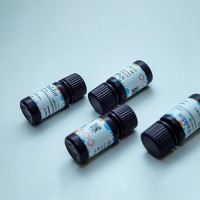Stabilizing Antibody Secretion of Human Epstein Barr Virus-Activated B-Lymphocytes with Hybridoma Formation by Electrofusion
互联网
|
Hybrid name |
Antibody secreted to |
IgG, �g/mL |
# EBV fused |
Heteromyeloma fusion partner |
Fusion medium |
dc Fusion voltage |
Range in hybridoma formation efficiency (5 ) |
|---|---|---|---|---|---|---|---|
|
Z10 (18 ) |
CMV |
5 |
2 � 106 |
SBC-H2O |
Iso-osmolar (14 ) |
3.0 kV/cm 3 pulses/15 �s |
34–68 |
|
X2-16 (19 ) |
CMV |
100 |
1.4 � 106 |
K6 H6 /B5 |
Iso-osmolar (14 ) |
3.0 kV/cm 3 pulses/15 �s |
6–18 |
|
IH-9 (20 ) |
HTLV-I |
3 |
105 |
K6 H6 /B5 |
Hypo-osmolar 75L3 |
1.0 kV/cm 3 pulses/15 �s |
141–258 |
|
WA-04 2B10 (4 ) |
HTLV-I |
40 |
1.5 � 105 |
H73C11 |
Hypo-osmolar 100L3 |
1.25 kV/cm 1 pulse/10 �s |
57–283 |
|
WA-11 1F5 (4 ) |
HTLV-I |
70 |
1.5 � 106 |
K6 H6 /B5 |
Iso-osmolar 300L3 |
1.75 kV/cm 3 pulses/15 �s |
40–96 |
|
JB-04 1D7 |
HCV |
90 |
106 |
K6 H6 /B5 |
Iso-osmolar 300L3 |
1.75 kV/cm 3 pulses/15 �s |
11–66 |
|
JB-16 2D6 |
HCV |
14 |
1.5 � 105 |
H73C11 |
Hypo-osmolar 100L3 |
1.25 kV/cm 1 pulse/10 �s |
194–388 |
|
JB-17 1D2 |
HCV |
60 |
1.5 � 105 |
K6 H6 /B5 |
Hypo-osmolar 100L3 |
1.25 kV/cm 3 pulses/15 �s |
80–200 |









